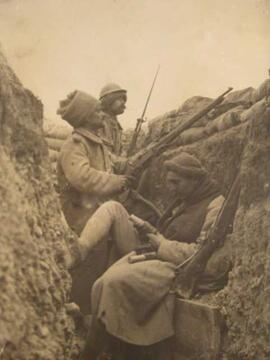PYMAN, Gen Sir Harold English (1908-1971)
- PYMAN
- Collection
- 1860-1901
The collection covers Pyman's career from 1937 until 1963 when he suffered a severe stroke which forced his retirement in 1964. The earliest papers date from Pyman's work with the Royal Tank Cadre in converting the 17/21 Lancers from a cavalry to an armoured regiment. There are also papers from Pyman's period as an instructor at the Staff College in Quetta, India, 1939-1941. Pyman was involved in the World War Two campaigns by the 8 Army in the Western Desert, in 1941 as General Staff Officer with 7 Armoured Div, 30 Corps and in 1942-1943 as Commander of the 3 Royal Tank Regiment, 10 Armoured Div, 30 Corps. The papers consist mostly of Pyman's assessments of lessons learned from the ongoing campaigns particularly with regard to tanks and armoured units. In 1944-1945 Pyman was Brigidier General Staff, 30 Corps, 2 Army in the Normandy landings and the invasion of Northern Europe, with particular responsibility for organisation and planning of the Rhine crossing and advance to the Baltic. This is reflected in the papers which largely consist of planning studies and reports for the operations involved, this section also contains maps used in the campaign. Pyman's next appointment was as Chief of General Staff, Allied Land Forces, South East Asia, 1945-1946 which is documented by a series of diaries which reflect the tasks faced by Pyman in this command including dealing with the build up of tension between newly liberated former colonies keen to assert their right for independence and the former colonial powers such as France and Netherlands. Pyman spent 1946-1949 as Chief of Staff, Middle East Land Forces and kept monthly diaries which form the bulk of this section of the collection. The diary entries and additional papers reflect the debate over policy in the Middle East in the British Government and Military command, they include detail on the British withdrawal from Greece, the problem of illegal Jewish immigrants and their internment in Cyprus, the end of the British mandate in Palestine and the the effect of this on relations between Britain with Egypt and the other Arab states and the subsequent Arab Israeli conflict. This section of the collection also contains correspondence between Pyman and Maj Gen Sir Miles Christopher Dempsey on personal matters and on the Middle East. There are also papers from Pyman's work at the Ministry of Supply as Director General of Fighting Vehicles, 1951-1953, Director of Weapons Development, War Office, 1955-1956 mostly brief diary entries and lecture texts. Pyman was also General Officer Commanding, British Army on the Rhine, 1953-1955 and General Officer Commanding, 1 British Corps, 1956-1958 and the papers relating to these commands consist mostly of lectures, reports and directives reflecting his interest in armoured divisions and training. There are some papers, mostly personal correspondence and press cuttings, from Pyman's final command as Commander-in-Chief Allied Forces Northern Europe in North Atlantic Treaty Organisation (NATO). The collection also contains correspondence relating to Pyman's role as Colonel Commandant of the Royal Tank Regiment and The Royal Armoured Corps and a series of letters covering the reorganisation of the Berks and Westminster Dragoons, of which he was Honorary Colonel. The rest of the collection consists of diaries, correspondence, speeches, writings including the draft copy and papers relating to his autobiography, some preparatory work on a history of the 2 Army and reference works. The collection also includes the Boer War diaries and other papers of Col James Redmond Patrick Gordon who commanded the 1 Cavalry Bde of the South African Field Force 1900-1901 which were given to Pyman by a friend.
Pyman, Harold English ('Pete'), 1908-1971, Knight, General


